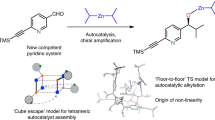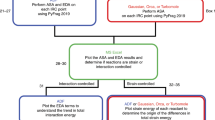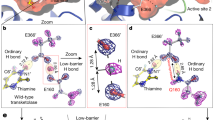Abstract
Single-molecule approaches to chemical reaction analysis can provide information that is not accessible by studying ensemble systems. Changes in the molecular structures of compounds tethered to the inner wall of a protein pore are known to affect the current carried through the pore by aqueous ions under a fixed applied potential. Here, we use this approach to study the substitution reactions of arsenic(III) compounds with thiols, stretching the limits of the protein pore technology to track the interconversion of seven reaction components in a network that comprises interconnected Walden cycles. Single-molecule pathway analysis of ‘allowed’ and ‘forbidden’ reactions reveals that sulfur–sulfur substitution occurs with stereochemical inversion at the arsenic centre. Hence, we demonstrate that the nanoreactor approach can be a valuable technique for the analysis of dynamic reaction systems of relevance to biology.
This is a preview of subscription content, access via your institution
Access options
Subscribe to this journal
Receive 12 print issues and online access
$259.00 per year
only $21.58 per issue
Buy this article
- Purchase on Springer Link
- Instant access to full article PDF
Prices may be subject to local taxes which are calculated during checkout





Similar content being viewed by others
References
Bayley, H., Luchian, T., Shin, S-H. & Steffensen, M. B. in Single Molecules and Nanotechnology (eds Rigler, R. & Vogel, H.) Ch. 10, 251–277 (Springer, 2008).
Luchian, T., Shin, S-H. & Bayley, H. Kinetics of a three-step reaction observed at the single molecule level. Angew. Chem. Int. Ed. 42, 1926–1929 (2003).
Luchian, T., Shin, S-H. & Bayley, H. Single-molecule covalent chemistry with spatially separated reactants. Angew. Chem. Int. Ed. 42, 3766–3771 (2003).
Shin, S-H. & Bayley, H. Stepwise growth of a single polymer chain. J. Am. Chem. Soc. 127, 10462–10463 (2005).
Loudwig, S. & Bayley, H. Photoisomerization of an individual azobenzene molecule in water: an on–off switch triggered by light at a fixed wavelength. J. Am. Chem. Soc. 128, 12404–12405 (2006).
Shin, S-H., Steffensen, M. B., Claridge, T. D. W. & Bayley, H. Formation of a chiral center and pyramidal inversion at the single-molecule level. Angew. Chem. Int. Ed. 46, 7412–7416 (2007).
Lu, S., Li, W-W., Rotem, D., Mikhailova, E. & Bayley, H. A primary hydrogen–deuterium isotope effect observed at the single molecule level. Nature Chem. 2, 921–928 (2010).
Wu, H. C. & Bayley, H. Single-molecule detection of nitrogen mustards by covalent reaction within a protein nanopore. J. Am. Chem. Soc. 130, 6813–6819 (2008).
Shin, S-H., Luchian, T., Cheley, S., Braha, O. & Bayley, H. Kinetics of a reversible covalent-bond forming reaction observed at the single molecule level. Angew. Chem. Int. Ed. 41, 3707–3709 (2002).
Shen, S., Li, X-F., Cullen, W. R., Weinfeld, M. & Le, X. C. Arsenic binding to proteins. Chem. Rev. 113, 7769–7792 (2013).
Liu, J. X., Zhou, G. B., Chen, S. J. & Chen, Z. Arsenic compounds: revived ancient remedies in the fight against human malignancies. Curr. Opin. Chem. Biol. 16, 92–98 (2012).
Argos, M., Ahsan, H. & Graziano, J. H. Arsenic and human health: epidemiologic progress and public health implications. Rev. Environ. Health 27, 191–195 (2012).
Messens, J. & Silver, S. Arsenate reduction: thiol cascade chemistry with convergent evolution. J. Mol. Biol. 362, 1–17 (2006).
Adams, S. R. & Tsien, R. Y. Preparation of the membrane-permeant biarsenicals FlAsH-EDT2 and ReAsH-EDT2 for fluorescent labeling of tetracysteine-tagged proteins. Nature Protoc. 3, 1527–1534 (2008).
Lloyd, N. C., Morgan, H. W., Nicholson, B. K. & Ronimus, R. S. The composition of Ehrlich's salvarsan: resolution of a century-old debate. Angew. Chem. Int. Ed. 44, 941–944 (2005).
Burchmore, R. J., Ogbunude, P. O., Enanga, B. & Barrett, M. P. Chemotherapy of human African trypanosomiasis. Curr. Pharm. Des. 8, 256–267 (2002).
Zhang, X. W. et al. Arsenic trioxide controls the fate of the PML-RARalpha oncoprotein by directly binding PML. Science 328, 240–243 (2010).
Jennewein, M. et al. Vascular imaging of solid tumors in rats with a radioactive arsenic-labeled antibody that binds exposed phosphatidylserine. Clin. Cancer Res. 14, 1377–1385 (2008).
Goldman, M. & Dacre, J. C. Lewisite: its chemistry, toxicology, and biological effects. Rev. Environ. Contam. Toxicol. 110, 75–115 (1989).
Henriksson, J., Johannisson, A., Bergqvist, P. A. & Norrgren, L. The toxicity of organoarsenic-based warfare agents: in vitro and in vivo studies. Arch. Environ. Contam. Toxicol. 30, 213–219 (1996).
Senkler, G. H. & Mislow, K. The barrier to pyramidal inversion in ethylmethylphenylarsine. J. Am. Chem. Soc. 94, 291 (1972).
Baechler, R. D., Casey, J. P., Cook, R. J., Senkler, G. H. & Mislow, K. Effect of ligand electronegativity on the inversion barriers of arsines. J. Am. Chem. Soc. 94, 2859–2861 (1972).
Dill, K., Huang, L., Bearden, D. W., McGown, E. L. & O'Connor, R. J. Activation energies and formation rate constants for arsenical-antidote adducts as determined by dynamic NMR spectroscopy. Chem. Res. Toxicol. 4, 295–299 (1991).
Serves, S. V., Charalambidis, Y. C., Sotiropoulos, D. N. & Ioannou, P. V. Reaction of arsenic(III) oxide, arsenous and arsenic acids with thiols. Phosphorus Sulfur Silicon 105, 109–116 (1995).
Richard, E. A. & Miller, C. Steady-state coupling of ion-channel conformations to a transmembrane ion gradient. Science 247, 1208–1210 (1990).
Hunt, R. A. & Otto, S. Dynamic combinatorial libraries: new opportunities in systems chemistry. Chem. Commun. 47, 847–858 (2011).
Acknowledgements
This work was supported by the Medical Research Council and a European Research Council advanced grant. H.B. was the holder of a Royal Society–Wolfson Research Merit Award. M.B.S. was the holder of a Ruth L. Kirschstein NIH Postdoctoral Fellowship (F32L078236).
Author information
Authors and Affiliations
Contributions
M.B.S. and D.R. contributed equally to this work. M.B.S. and H.B. designed the research. M.B.S. performed the experimental work. M.B.S., D.R. and H.B. analysed data and wrote the manuscript.
Corresponding author
Ethics declarations
Competing interests
The authors declare no competing financial interests.
Supplementary information
Supplementary information
Supplementary information (PDF 778 kb)
Rights and permissions
About this article
Cite this article
Steffensen, M., Rotem, D. & Bayley, H. Single-molecule analysis of chirality in a multicomponent reaction network. Nature Chem 6, 603–607 (2014). https://doi.org/10.1038/nchem.1949
Received:
Accepted:
Published:
Issue Date:
DOI: https://doi.org/10.1038/nchem.1949
This article is cited by
-
Precise Detection, Control and Synthesis of Chiral Compounds at Single-Molecule Resolution
Nano-Micro Letters (2023)
-
Directional conformer exchange in dihydrofolate reductase revealed by single-molecule nanopore recordings
Nature Chemistry (2020)
-
Distinct functional elements for outer-surface anti-interference and inner-wall ion gating of nanochannels
Nature Communications (2018)
-
Role of outer surface probes for regulating ion gating of nanochannels
Nature Communications (2018)
-
Theoretical insights into aggregation-induced helicity modulation of a perylene bisimide derivative
Journal of Molecular Modeling (2018)



